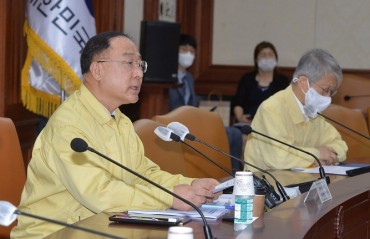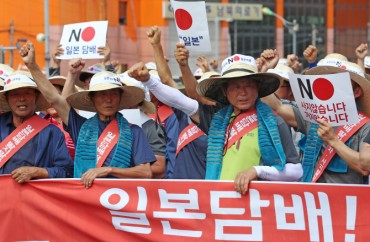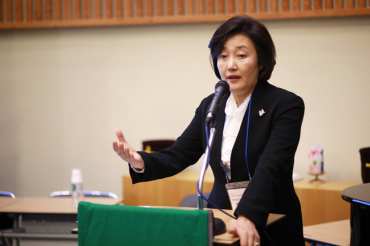
Municipal workers take a mask off a statue of a primitive man in Dalseo Ward of the southeastern city of Daegu on May 2, 2022, as the country allowed people to not wear masks outside starting the same day amid a decreasing trend in the number of daily COVID-19 cases, in this photo released by the ward office. The office placed the mask on the 20-meter-long and 6-meter-high structure on May 15, 2020, to encourage people to wear masks amid a surge in the number of coronavirus infections.
SEOUL, May 3 (Korea Bizwire) — South Korea’s new COVID-19 cases rose to over 50,000 on Tuesday from a nearly three-month low the previous day, and health authorities remained vigilant after confirming the first case of a more infectious omicron subvariant.
The country reported 51,131 new COVID-19 infections, including 45 from overseas, bringing the total caseload to 17,346,753, the Korea Disease Control and Prevention Agency (KDCA) said.
Tuesday’s caseload more than doubled from the previous day’s 20,084. But it was still a marked drop from a week earlier when the figure stayed above 80,000.
As of 9 p.m., the country had added 47,732 new COVID-19 cases, down 1,775 from the same time the previous day, according to health authorities and city governments. Daily cases are counted until midnight and announced the following morning.
The country experienced the worst virus wave over the fast spread of the highly contagious omicron variant, with the daily count soaring to over 620,000 in mid-March. But the figure has been below five digits since April 21.
The authorities, however, remained on alert as the country reported the first case of the omicron subvariant dubbed BA.2.12.1 on Tuesday.
A woman in her 50s arrived in South Korea on April 16 from the United States and was confirmed to have been infected with the coronavirus the following day.
“Compared with the BA.2 variant, the new strain presumably spread up to 27 percent faster, but it is yet to be known whether the subvariant causes more serious infections,” KDCA official Park Young-jun said.
“Contact tracing is now under way. We’ve been closely monitoring the inflow of the new variant,” Park added.
The new sub-lineage of the omicron variant has caused a recent surge in infections in New York and elsewhere.

High school students in Seoul pose for a photo ahead of a school trip on May 2, 2022, as the country has eased strict social distancing curbs to help the people return to normalcy. (Yonhap)
On Tuesday, the country added 49 COVID-19 deaths, down from Monday’s 83, bringing the total to 23,007, the KDCA said. The fatality rate stood at 0.13 percent.
The number of critically ill patients came to 417, compared with 461 reported the previous day. The figure has been on the decline in recent days, staying in the 400s for four days in a row, according to the health authorities.
Some 25.2 percent of hospital beds reserved for seriously ill COVID-19 patients were occupied Tuesday, and the number of at-home treatment patients also fell nearly 40,000 to 280,030, the KDCA said.
The KDCA lowered the risk level of the virus in non-metropolitan areas by one notch to moderate in its five-tier system over the recent downward trend. The level for the metropolitan region remained the same at moderate since late last month.
The infections reported last week marked a 34 percent fall from the previous week, and COVID-19 deaths went down 32.2 percent over the past week, the KDCA said.
In line with the recent downward trend, the government has eased strict antivirus rules to support the people’s return to normalcy.
On Monday, the government lifted the outdoor mask mandate after more than 18 months of enforcement, except for large gatherings of 50 or more.
Last month, the government also fully lifted private gathering limits and business hour curfews.
But mask wearing is still recommended when it is difficult for people to keep a 1-meter distance from each other at gatherings and in circumstances where lots of droplets of saliva could be expelled, such as shouting and singing.
The government also made it clear that indoor mask wearing needs to be in place for some time.
As of midnight Monday, 44.55 million people, or 86.8 percent of the population, had been vaccinated with two shots, and 33.14 million people had received their first booster shots, representing 64.6 percent.
The number of those that got second booster shots came to 2.2 million, which accounted for 4.4 percent of the country’s total population, the KDCA said.
(Yonhap)






